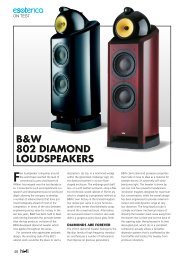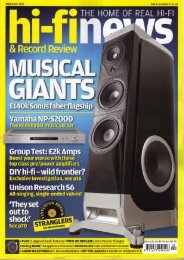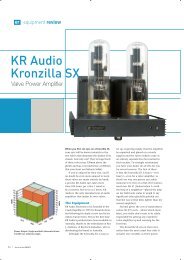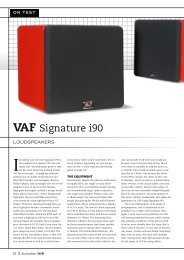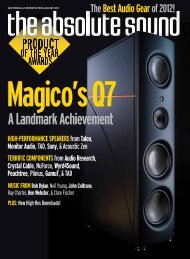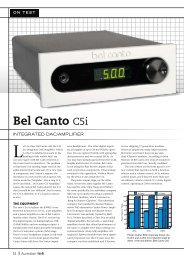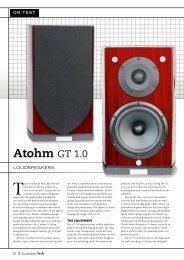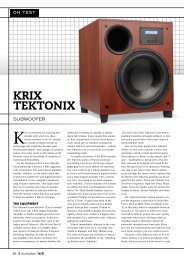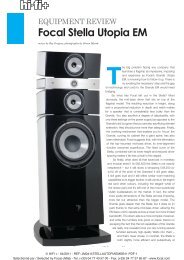THORENS TD 309 - Ultra High-End Audio and Home Theater Review
THORENS TD 309 - Ultra High-End Audio and Home Theater Review
THORENS TD 309 - Ultra High-End Audio and Home Theater Review
You also want an ePaper? Increase the reach of your titles
YUMPU automatically turns print PDFs into web optimized ePapers that Google loves.
O N T E S T<strong>THORENS</strong> <strong>TD</strong> <strong>309</strong> TRI-BALANCE TURNTABLE(For confused readers, Barbarian is a reworkingof Bartóks’ Allegro Barbaro <strong>and</strong> KnifeEdge sounds a lot like a melding of the firstmovement of Janácek’s Sinfonietta with theallem<strong>and</strong>e from Bach’s French Suite in D minor,BWV 812.)So if I purchased the <strong>TD</strong> <strong>309</strong>, I certainlywould not be ripping out the <strong>Audio</strong> Technicacartridge that comes with it any time realsoon. I would instead enjoy what is essentiallya ‘freebie’ from Thorens, <strong>and</strong> use it torip my vinyl to electronic files, <strong>and</strong> spend myspare moments imagining which movingcoilcartridge I’d eventually get around toreplacing it with some time down the track.One minor grievance here is that because ofthe unusual tonearm design, you can’t easilyplug different cartridges in <strong>and</strong> out of thetonearm, so it would be largely impractical(although certainly possible!), for example, touse a budget cartridge to play your scratched<strong>and</strong> damaged LPs <strong>and</strong> reserve an expensivehigh-end cartridge for your more pristinealbums. Still, few high-end tonearms thesedays have plug-in headshells that wouldallow this, so it could hardly be levelled as acriticism when talking about the <strong>TD</strong> <strong>309</strong>.The performance of the <strong>Audio</strong> Technicawas certainly more than sufficient to allowme to completely evaluate all aspects of the<strong>TD</strong> <strong>309</strong>’s performance because all of themost important turntable attributes do notdepend on a cartridge’s technical ability orsound quality at all. Take speed accuracy, forexample. You can determine whether or nota platter is rotating at the correct speed byusing a strobe card. If you don’t already haveone, there’s a free one available here: [www.avhub.com.au/images/stories/pdf/strobe.pdf] My card showed the platter was rotatingslightly fast at both 33.33rpm <strong>and</strong> 45rpm, soI had to adjust the speed using the two tinyscrew adjusters located to the left (for 33.33)<strong>and</strong> right (for 45) of the speed switch tofine-tune it. Rather confusingly, I found thatturning the grub screws clockwise actually decreasesspeed, whereas I would have expectedthe opposite to be the more natural directionto do this! Also, while making these adjustments,I discovered that adjusting one speedhas a tiny effect on the speed of the other, soeventually I settled on getting the 33.33 rpmspeed as accurate as I could <strong>and</strong> settling forthe 45 being slightly fast. Newport Test Labslater reported that even after my optimal setting,circuit drift (<strong>and</strong> perhaps the shippingover to the lab?) had subsequently increasedthe platter speed 0.2% fast at 33.33rpm <strong>and</strong>0.3% fast at 45rpm, which they reset beforetesting. As you can tell from the percentagesthis is a very tiny error indeed—so tiny thateven someone with perfect pitch would beunable to hear the difference—assuming thatthe recording that was being replayed wasactually recorded at the correct speed in thefirst place (a great many LPs are not), so Iwouldn’t be overly concerned about trying tokeep the platter speed exact: even turntableswith a.c. synchronous motors can rarelyachieve this!You also don’t need an audiophile cartridgeto hear if a turntable has unwantedlow-speed variations (known as ‘wow’) orhigher-speed variations (‘flutter’). I usedthe usual music to test for both (slow pianomusic… I used Erik Satie, but any slowpiano music would do) <strong>and</strong> can report that Iheard absolutely no wow or flutter whatsoever.(Again, Newport Test Labs measuredlow levels of wow <strong>and</strong> flutter—0.06% RMSunweighted/0.05% CCIR weighted—soalthough you can certainly benchmark theirreported results against some other turntableto see which had the ‘lowest’ levels, the factis that the levels are so low that you won’tbe able to hear any wow <strong>and</strong> flutter effectsat all—they’re below the level of audibility.)If you DO hear some wow <strong>and</strong> flutter, it willbe because the belt is too loose, <strong>and</strong> in thiscase all you have to do is rotate the motor inits sleeve until the belt is just tight enoughthat the wow <strong>and</strong> flutter disappears—but notighter!I also checked for the potential for intermodulationdistortion: not by listening,but by ‘firing’ a laser-beam across the topsurface of the platter while it was rotating.This allows me to check the turntable bearingalignment <strong>and</strong> platter flatness to make surethe platter won’t move the arm up <strong>and</strong> downwhile it’s tracing the record, which wouldcause intermodulation distortion (IMD). The<strong>TD</strong> <strong>309</strong> performed brilliantly in this test: thebearing, bearing location <strong>and</strong> the surface aresuperb!Unwanted low-frequency noise (the infamous‘rumble’) is the bête noire of turntabledesign, whether it issues from the motorthat’s driving the platter, or the rotation ofthe platter bearing itself. It’s also extraordinarilydifficult to discern the contributionfrom the turntable itself, because all records,even audiophile pressings, contain unwantedlow-frequency noise… usually caused bythe recording lathe. Because of this, I checkfor rumble using acetate (not vinyl) mastersspecially cut for the purpose, using a filterto remove high-frequency ‘surface’ noisecaused by the stylus travel. Using this set-upI couldn’t hear any rumble at all, even whenI turned the volume up to well above normalplayback levels. As a result of this, I can confidentlysay you won’t hear any low-frequencynoise caused by the <strong>TD</strong> <strong>309</strong> when playingback your LPs, irrespective of whether they’resuper-quiet audiophile pressings or normalcommercial ones.Turntable isolation (how well it rejectsair-borne <strong>and</strong>/or surface-borne vibrations)is so difficult to consistently <strong>and</strong> reliablyevaluate (the old ‘thump the desk alongsidethe turntable while an LP is playing’ testdoesn’t really cut it) that I hesitate to be tooprescriptive about the performance of the <strong>TD</strong><strong>309</strong>. Overall, however, I’d say that it returned‘better than average’ performance within itsprice class (talking absolutes, Clearaudio’sStatement turntable clearly outperforms it!).ConclusionThe <strong>TD</strong> <strong>309</strong> is a breath of fresh air fromThorens. This stylish new design is undoubtedlyamongst the best-performing turntablesThorens has ever manufactured, <strong>and</strong> iscertainly fitted with one of its best arms ever,yet its asking price is set so far below what I’dhave thought Thorens would ask for it thatI genuinely wonder if it is being sacrificed asa ‘loss leader’ to gain some free publicity forthe company. If this is indeed the case, <strong>and</strong>you like the look <strong>and</strong> sound of the <strong>TD</strong> <strong>309</strong>,I’d suggest you take advantage of the pricewhile you can. And from Thorens’ point ofview, if you’d like a turntable but want somethingthat looks more traditional, or is lowerpriced (or, for that matter, higher-priced), the<strong>TD</strong> <strong>309</strong> has already done its job by gainingThorens some free publicity (not to mentionthat EISA award for ‘Best Turntable’), so as aresult you’re probably more likely than youotherwise might have been to look at thedozens (literally!) of other turntables bearingthe famous Thorens badge…greg borrowman28 Australian



